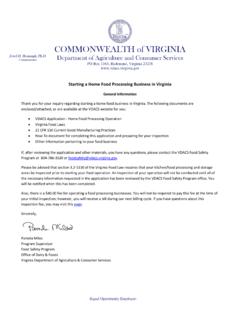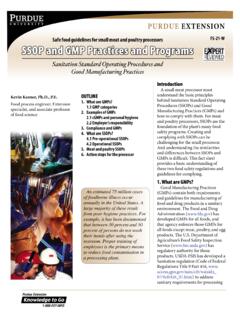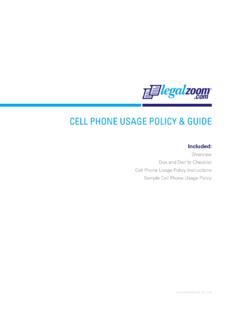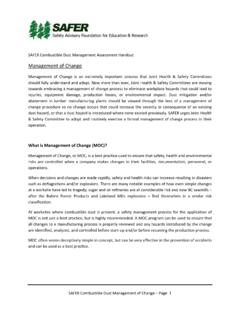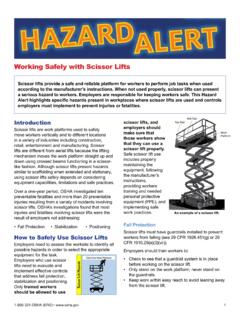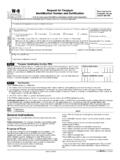Transcription of 2016 PEST MANAGEMENT STANDARDS FOR FOOD …
1 2016 PEST MANAGEMENT STANDARDS FOR FOOD PROCESSING & HANDLING FACILITIESPest MANAGEMENT STANDARDS for Food Processing & Handling Facilities iPest MANAGEMENT STANDARDS for Food Processing & Handling Facilities | Introduction INTRODUCTIONThe National Pest MANAGEMENT Association (NPMA) is pleased to release the 2016 Pest MANAGEMENT STANDARDS for Food Processing and Handling Facilities. Since 2007, NPMA guidance on pest MANAGEMENT in food facilities has been the cornerstone of NPMA s commercial activities. These STANDARDS were last updated in 2013 and this 2016 version provides updates and improvements to better address changing regulatory requirements, new technologies and better integrated pest MANAGEMENT practices .
2 The publication of this 2016 revision coincides with the implementation of the Food Safety Modernization Act (FSMA). FSMA will reform our food safety system by ensuring a safe food supply based on prevention rather than reaction. The new FSMA STANDARDS will bring increased scrutiny and oversight to the entire food industry which requires sanitation STANDARDS only achievable through proper pest MANAGEMENT practices . Of note in the 2016 revision the name was changed from Pest MANAGEMENT STANDARDS for Food Plants to Processing and Handling Facilities to better reflect the intended scope of these STANDARDS . Other new additions include addressing the use of remote monitoring technology and the addition of a sample risk assessment that may be used as a reference to assist in analyzing, creating and maintaining a successful pest MANAGEMENT plan.
3 In the 2013 revision we moved away from prescriptive instructions regarding placement and monitoring frequency in favor of a results oriented approach based on trends, inspection and observations. The 2016 revision maintains this approach but provides some baselines in situations where historical data is STANDARDS are general guidance for the industry and require the use of independent judgment when implementing a pest MANAGEMENT plan in food processing and handling facilities. As stated in previous editions, these STANDARDS do not preempt local, state, or federal laws and regulations. Any service provided must comply with relevant statutes and regulations governing pest MANAGEMENT , safety and food protection.
4 In addition, food plants may have requirements more stringent than these demonstrate understanding on these STANDARDS , NPMA maintains study materials and an online exam at Upon successful completion, the system generates a completion certificate. Printed study guides and STANDARDS can be purchased from NPMA at Through online testing and food safety resources, NPMA is working to provide ii 2016 National Pest MANAGEMENT Association, MANAGEMENT STANDARDS for Food Processing & Handling Facilities | IntroductionPest MANAGEMENT STANDARDS for Food Processing & Handling Facilities | Introductionthe tools necessary for pest MANAGEMENT firms to comply with the STANDARDS and raise the level of competency of pest MANAGEMENT professionals servicing food hope that you find these STANDARDS to be a beneficial resource for your organization.
5 As protectors of food and property and defenders of public health it is our industry s obligation to exceed expectations and demonstrate the pest MANAGEMENT industry s vital role in food safety. Standard Section 3 | Table of ContentsPest MANAGEMENT STANDARDS for Food Processing & Handling Facilities iiiPest MANAGEMENT STANDARDS for Food Processing & Handling Facilities | Table of Contents TABLE OF CONTENTS SECTION PERSONNEL 1 employee Identification 3 Uniforms 4 Security and Criminal Background Checks 5 Facility Personnel practices 6 Vehicles 7 Safety 8 Minimum Training STANDARDS for Technicians 9 Compliance with Food Safety Rules CGMPs 10 SECTION PEST MANAGEMENT PLAN 11 Rodent Program Exterior Property Survey 13 Rodent Program Interior Survey 14 Rodent Program Facility History 15 Rodent Program
6 Frequency of Service 16 Rodent Program Spacing of Rodent MANAGEMENT Devices 17 Rodent Program Monitoring 19 Remote Electronic Monitoring Technology 20 Insect Program 21 Birds and Wildlife 24 Weed MANAGEMENT 25 Pest MANAGEMENT Survey 26 Storage Standard Number 27 Compliance with Facility Food Allergen Control Program 28 Quality Assurance 29 Annual Training 30 Annual Review 31 SECTION COMMUNICATIONS 33 Reporting 35 SECTION RECORDKEEPING AND CONTRACTS 37 Contracts 39 Labels and Safety Data Sheets 40 Pest Sighting Log 41 Licenses and Certificates 42 Service Protocols and Standard Operating Procedures 43 Service and Treatment Records 44 SECTION NATIONAL ORGANIC PROGRAM 45 Working in NOP Facilities 47 APPENDIX A PEST MANAGEMENT INSPECTION REPORT 49 APPENDIX B SAMPLE RISK ASSESSMENT 51 APPENDIX C CURRENT GOOD MANUFACTURING practices , 21 117 57iv 2016 National Pest MANAGEMENT Association, MANAGEMENT STANDARDS for Food Processing & Handling Facilities | Definitions DEFINITIONSFor definition purposes, Action Threshold means level of pest activity or pest damage that triggers a pest MANAGEMENT means the pest MANAGEMENT firmContact means the food facility contact personCurrent Good Manufacturing practices means the FDA s Current Good Manufacturing practices (CGMPs)
7 In the United States, or equivalent outside of the any equipment used to monitor or control pests including, but not limited to, insect monitors, rodent bait stations, insect light traps, pheromone traps, and rodent MANAGEMENT means pest MANAGEMENT firm employeeFacility is used interchangeably throughout these STANDARDS as the shortened version for Food Processing and Handling Facility Food Processing and Handling Facility means any food facility engaged in food production, manufacturing, storing/warehousing and distribution. This does not include restaurants or other food service facilities. Pest MANAGEMENT product means any lure, bait, monitoring product, pesticide, or any other formulated material used in performance of pest MANAGEMENT bait station means any station used for placement of solid rodenticide baitRodent MANAGEMENT device means any device used for monitoring or managing rodents.
8 These include mechanical traps, rodent bait stations (see above), and other placed equipment for rodent MANAGEMENT . Technician means the pest MANAGEMENT firm employee providing serviceWe hope that you find these STANDARDS to be a beneficial resource for your organization. As protectors of food and property and defenders of public health it is our industry s obligation to exceed expectations and demonstrate the pest MANAGEMENT industry s vital role in food safety. Pest MANAGEMENT STANDARDS for Food Processing & Handling Facilities 1 SECTION 1 PerSonnelStandard Section 1 | PersonnelStandard Section 1 | Personnel2 2016 national Pest MANAGEMENT Association, Section 1 | PersonnelPest MANAGEMENT STANDARDS for Food Processing & Handling Facilities employee IDENTIFICATIONBoth food security and safety are the primary concern of the food facility.
9 This section sets forth minimum STANDARDS for company employee identification so that the facility has a clear understanding of which personnel are from the pest MANAGEMENT company to ensure that facility food safety and security are employees entering grounds of a food facility shall display photo identification to include: employee name employee identification number (if issued by the company) Company name Company phone number employee photo Date of issueThe identification shall be displayed at all times while the employee is on site unless personnel practices set by the facility prohibit such badges. In addition, facilities may require other identification such as visitor badges or facility issued contractor badges and the employee must comply at all times with the visitor/contractor policies of the Section 1 | PersonnelStandard Section 1 | Personnel4 2016 national Pest MANAGEMENT Association, UNIFORMSU niforms are an important part of the facility safety and STANDARDS program.
10 Criteria are designed to comply with the majority of food facility requirements and CGMPs for employees who perform service work in food facilities shall wear uniforms meeting current facility requirements and at least the following criteria: Slip resistant sole shoes (safety toe if required by facility) Socks long pants Shirt with sleeves (short or long) with company logo or company name Uniform closures shall be in compliance with facility clean set of clothing shall be used in facilities. If the uniform is exposed to contaminants a clean set of clothing should be readily available. These contaminants include but are not limited to chemical, microbiological, or allergens such as peanut products.


